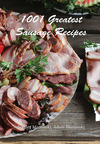Meats and Sausages
Making Jam and Jelly
Making Jelly
In order to make a jelly, jam or marmalade the gel must first be produced and the product must be allowed to set. Very few fruits contain sufficient amounts of pectin to produce a jelly. We compensate for this by carefully selecting fruit(s) and adding the necessary amount of sugar. This process has been in recent times largely simplified by adding commercial pectin.
The correct amount of the following substances are needed to create a gel:
- Pectin
- Acid
- Sugar
- Water
A sufficient amount of these ingredients allows for the creation of a firm and elastic jelly.
Pectin molecules are loosely connected to each other and to water particles. Sugar displays a great affinity for water and when added to juice or fruit, will try to grab some water which is bound to pectin. There must be a sufficient amount of acid in the fruit for this to occur as acid helps water molecules to break loose from pectin and connect with sugar. Water that has left the pectin structure creates spaces, which allow the pectin molecules to come closer together, and the gel is created.
Most recipes include some lemon juice, not for the taste but for better gel creation. By adding 1 or 2 tablespoons of bottled lemon juice to a very sweet fruit, we can achieve a correct acidic balance. See the acid test.
To be sure whether the fruit juice will gel, the pectin alcohol test should be administered first. See pectin alcohol test.
Jellies are probably the most difficult products to make as they require pectin rich fruits and more attention to detail. Although all fruits contain some pectin, only crabapples, quinces, unripe kumquats (citrus tree), Damson plums, grapes, and some berries contain sufficient amounts of pectin and acid to produce a strong gel. Such fruits are of course well suited for making other jellied products too.
The main characteristics that distinguish jelly from other products are:
- Jelly is made by cooking filtered juice with sugar.
- It must be clear so the fruit pulp must be drained, but not pressed. Its clarity and sparkle determine quality.
- Its gel must be strong enough to hold the shape of the container when removed.
Making Jam
Jam is made by cooking crushed or cut fruits with sugar. Jams and preserves are not characterized by such a firm gel structure as jellies and require a lesser amount of pectin. Thus, a larger variety of fruits can be selected for making jams. This, plus the elimination of a time consuming filtering step, makes them easier to make than jellies. Although less firm than jellies, they must still be thick enough to spread.
The processing steps for making jam and making jelly remain basically the same, with the slight difference in selecting and preparing the fruit for jellies as explained in Fruit Preparation.
















